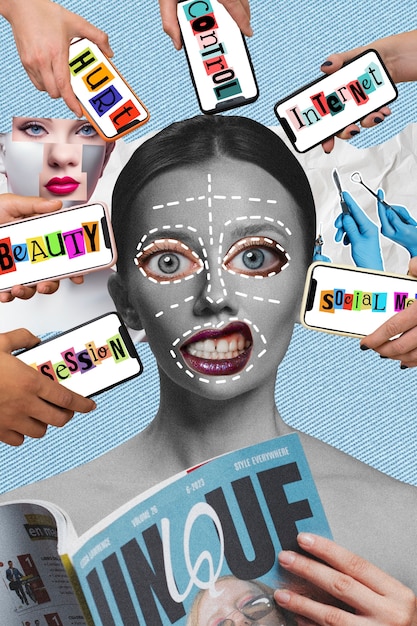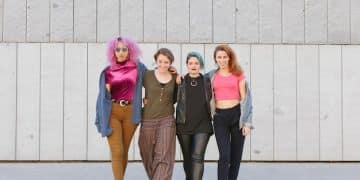K-Pop Copyright Guide: US Fan Content & Legal Rights

Understanding K-Pop copyright laws is essential for US fans creating fan-made content, ensuring they respect intellectual property rights while expressing their creativity within legal boundaries.
Navigating the world of K-Pop fan content can be exciting, but it’s crucial to understand the legal landscape. This article demystifies the complex copyright laws surrounding K-Pop, equipping US fans with the knowledge to create and share their passion without infringing on intellectual property rights. Let’s dive into Understanding K-Pop Copyright Laws: What US Fans Need to Know About Fan-Made Content.
Copyright Basics for K-Pop Fans in the US
Copyright law is a complex beast, but understanding its fundamentals is crucial for any content creator. Here’s a breakdown of the key aspects US-based K-Pop fans need to know.
What Does Copyright Protect?
Copyright protects original works of authorship, including musical compositions, recordings, choreography, and visual content. This means K-Pop songs, music videos, and even dance routines are all protected by copyright.
Who Owns the Copyright?
Typically, the copyright owner is the creator of the work, or the company that employs the creator. In the K-Pop industry, entertainment companies like SM Entertainment, YG Entertainment, and JYP Entertainment usually own the copyright to their artists’ music and related content.
Understanding “Fair Use”
“Fair use” is a legal doctrine that allows limited use of copyrighted material without permission from the copyright holder. This is where things get tricky for fan content creators. Here’s a breakdown:
- Purpose and Character of the Use: Is your use transformative? Are you adding something new or simply copying the original?
- Nature of the Copyrighted Work: Is the original work factual or creative? Copyright protection is generally stronger for creative works.
- Amount and Substantiality of the Portion Used: How much of the original work are you using? Using a small portion is more likely to be considered fair use.
- Effect of the Use on the Potential Market: Does your use harm the market for the original work? If your fan content is a substitute for the original, it’s less likely to be considered fair use.
Determining fair use is a case-by-case analysis, and there’s no guaranteed formula. It’s about balancing the rights of copyright holders with the public’s interest in creative expression.
In conclusion, understanding copyright basics is the first step in creating K-Pop fan content legally. It’s essential to be aware of what’s protected, who owns the rights, and the nuances of fair use.
Navigating K-Pop Fan-Made Content Legally
Creating fan content is a beloved tradition in the K-Pop community. Knowing how to do it legally protects both you and the artists you admire. Here’s how to navigate the process.
Fan Edits and Compilations
Creating fan edits or compilations using K-Pop songs and music videos is common, but it’s essential to consider copyright implications. Avoid using entire songs or large portions of music videos. Instead, focus on short clips and transformative edits that add your own creative flair.
Cover Songs and Dance Covers
Covering K-Pop songs or dances is a fantastic way to show your appreciation, but you need to be aware of performance rights. If you’re performing live or distributing your cover online, you may need to obtain licenses from the copyright owners or performing rights organizations like ASCAP or BMI.
Fan Fiction and Art
Fan fiction and art inspired by K-Pop groups are generally considered protected by fair use as long as they don’t directly replicate existing copyrighted material. Transformative works that feature original characters and storylines inspired by K-Pop are less likely to infringe on copyright.

Best Practices for Staying Legal
- Give Credit: Always credit the original copyright holders for any material you use.
- Seek Permission: If you’re unsure about whether your use is fair, ask for permission from the copyright holder.
- Transformative Use: Add your own creative spin to the original work to make it transformative.
- Non-Commercial Use: Avoid using copyrighted material for commercial purposes without permission.
Remember, being aware of copyright laws and respecting the rights of copyright holders can help you create and share your K-Pop fan content legally. It’s about finding a balance between creative expression and intellectual property rights.
The Legal Minefield of K-Pop Dance Covers
Dance covers are a popular form of tribute in the K-Pop fandom, but they also present several legal considerations. Let’s explore the key aspects to keep in mind when creating and sharing your dance covers.
Copyright and Choreography
Choreography is protected by copyright, meaning that the dance routines created for K-Pop songs are legally protected. Replicating these routines in your dance covers requires careful consideration.
Monetization Concerns
Monetizing your dance covers on platforms like YouTube can lead to copyright claims and takedowns. If you’re earning money from your videos, you’re more likely to face scrutiny from copyright holders.
Navigating Music Rights
Even if you’re not monetizing your dance cover, you still need to consider the music rights. YouTube’s Content ID system automatically detects copyrighted music and may place ads on your videos, with the revenue going to the copyright holders.
Ways to legally post your covers:
- Non-profit Use: Specify that your use is purely for entertainment.
- Permission: Reach out to the right holders for permission and give credit
- License: Pay for a license to utilize the music
Creating K-Pop dance covers can be a fun and rewarding experience, but it’s crucial to be aware of the legal implications. By respecting copyright laws and taking proactive steps to protect yourself, you can share your passion without legal repercussions.
In conclusion, dance covers demand a balanced approach: respecting copyright laws, carefully handling monetization, and understanding music rights.
DMCA Takedowns and Copyright Strikes: What to Do?
Receiving a DMCA takedown notice or a copyright strike can be daunting, but understanding your rights and options is essential. Here’s what you need to know.
Understanding DMCA Takedowns
The Digital Millennium Copyright Act (DMCA) is a US law that allows copyright holders to request the removal of infringing content from online platforms. If you receive a DMCA takedown notice, it means a copyright holder believes your content infringes on their rights.
Copyright Strikes on YouTube
YouTube operates under a three-strikes policy, meaning that if you receive three copyright strikes, your account will be terminated. Copyright strikes can result from using copyrighted material without permission.
How to Respond to a Takedown Notice
If you receive a DMCA takedown notice, you have several options:
- Remove the Content: The simplest option is to remove the infringing content to avoid further action.
- Submit a Counter-Notification: If you believe the takedown notice is mistaken, you can submit a counter-notification arguing that your use is fair use or that you have the right to use the material.
- Seek Legal Advice: If you’re unsure about your rights, consult with an attorney specializing in copyright law.

Preventing Future Issues
To avoid DMCA takedowns and copyright strikes in the future, take proactive steps to ensure your content is legally compliant. Always give credit to the original copyright holders, seek permission when necessary, and make sure your use is transformative.
DMCA takedowns and copyright strikes can be alarming to receive. Being informed about your rights and acting promptly can help you navigate the process and avoid unnecessary legal issues.
The Role of K-Pop Companies in Copyright Enforcement
K-Pop entertainment companies play a significant role in copyright enforcement, protecting their artists’ intellectual property. Understanding their strategies and motivations can help fans navigate the legal landscape more effectively.
Protecting Their Intellectual Property
K-Pop companies invest significant resources in creating and promoting their artists’ music, videos, and choreography. Protecting this intellectual property is essential to their business model.
Copyright Enforcement Strategies
K-Pop companies use a variety of strategies to enforce their copyrights, including:
- Monitoring Online Platforms: Companies actively monitor platforms like YouTube, TikTok, and social media for infringing content.
- Sending Takedown Notices: They send DMCA takedown notices to remove infringing content from online platforms.
- Legal Action: In some cases, companies may pursue legal action against individuals or organizations that repeatedly infringe on their copyrights.
Balancing Protection and Fan Engagement
While K-Pop companies prioritize copyright protection, they also recognize the importance of fan engagement. Many companies allow fans to create and share non-commercial content as long as it doesn’t infringe on their rights.
In conclusion, understanding the role of K-Pop companies in copyright enforcement can help fans create and share content on the right side of copyright law.
US Copyright Law vs. South Korean Copyright Law: Key Differences
When it comes to K-Pop, understanding the nuances between US and South Korean copyright laws is essential for US-based fans. Different regions and content must abide by the laws that govern said region.
Territoriality of Copyright
Copyright laws are territorial, meaning that they only apply within the country that enacted them. This means that a work protected by copyright in South Korea may not be protected in the same way in the United States.
Fair Use vs. Fair Dealing
The US uses the concept of “fair use,” which allows limited use of copyrighted material without permission from the copyright holder. South Korea uses the concept of “fair dealing,” which is similar to fair use but may have different criteria for determining what constitutes fair dealing.
Enforcement Mechanisms
The enforcement mechanisms for copyright laws may also differ between the US and South Korea. Understanding these differences can help US fans navigate the legal landscape more effectively.
Being informed about the differences between US and South Korean copyright laws can help US fans create and share K-Pop content while remaining compliant with the law.
| Key Point | Brief Description |
|---|---|
| 🎵 Copyright Basics | Understanding what copyright protects and who owns the rights. |
| 🎨 Fan Content | Creating edits, covers, and art while respecting copyright. |
| 💃 Dance Covers | Considerations for choreography and music rights in dance covers. |
| ⚠️ DMCA Takedowns | Responding to takedown notices and preventing future issues. |
FAQ
▼
Fair use is a legal doctrine permitting limited use of copyrighted material without permission. Factors include the purpose, nature, amount used, and market effect.
▼
Monetizing dance covers can lead to copyright claims. Ensure you have the necessary licenses or permissions to avoid issues.
▼
If you receive a DMCA takedown, you can remove the content, submit a counter-notification, or seek legal advice based on your situation.
▼
Yes, choreography is protected by copyright. Replicating routines without permission can lead to legal issues.
▼
Key differences include territoriality, the fair use vs. fair dealing standards, and enforcement mechanisms specific to each country.
Conclusion
Understanding and respecting K-Pop copyright laws is essential for US fans creating fan-made content. By staying informed and following best practices, fans can continue to express their creativity while avoiding legal pitfalls and supporting the artists they love.





